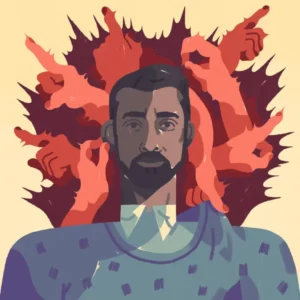If you are someone who experiences obsessive thoughts and compulsions related to your gender identity, you may have heard of trans-OCD or Transient OCD. This type of OCD is unique in that the obsessions and compulsions are specifically related to thoughts and doubts about one’s gender identity. If you are struggling with trans-OCD, it can be incredibly difficult to cope with day-to-day life. In this blog post, we will discuss what trans OCD is, how to get help, and some tips for managing symptoms.
Contents
What Is Trans OCD?

Trans OCD is a subtype of Obsessive-Compulsive Disorder (OCD) that is characterized by persistent and intrusive thoughts about one’s gender identity. These thoughts can result in significant distress and may lead to compulsions, such as repeatedly checking social media or researching to confirm one’s gender identity. Trans OCD can also involve avoidance behaviors, such as avoiding people or places that trigger doubts about one’s gender identity.
How Is Trans OCD Different from Gender Dysphoria?
It is important to note that trans-OCD is different from gender dysphoria, which is the experience of discomfort or distress due to a mismatch between one’s assigned sex at birth and their current gender identity. While both conditions can be extremely distressing, trans-OCD distinguishes by the presence of obsessive thoughts and compulsions relating to gender identity.
It is also important to understand that trans-OCD is not the same as being transgender. Transgender people do not experience obsessions or compulsions related to their gender identity; rather, they have a strong and consistent identification with a gender other than the one they were assigned at birth.
It must also be put into consideration that this fear has nothing to do with a person hating, disliking, or being afraid of other people who are gay or transgender. It is a persistent fear of not being able to figure out one’s own identity.
Causes

OCD can result from a combination of genetic and environmental factors. Like other forms of OCD, trans-OCD may be triggered by stressful life events or trauma. It is also believed that there may be a biological component, as trans-OCD has been found to run in families.
Symptoms
If you are struggling with intrusive thoughts about your gender identity, it is important to seek professional help. A therapist who specializes in OCD can help you to understand whether your symptoms meet the criteria for a diagnosis. Symptoms of trans-OCD may include:
- Persistent and intrusive thoughts about gender identity
- Avoidance of people or places that trigger doubts about gender identity
- Compulsions such as repeatedly checking social media or researching to confirm one’s gender identity
- Intrusive and persistent thoughts about one’s gender identity
- Excessive doubt about one’s gender identity
- Feeling like they’re faking their identity or doing it for attention
- Worrying that people close to them won’t accept their gender identity
- Significant distress related to thoughts about gender identity
Effects

Trans OCD can have a profound impact on every aspect of a person’s life.
- The persistent and intrusive thoughts can lead to significant distress, anxiety, and depression.
- Trans-OCD can also interfere with work, school, and social relationships.
- It can also lead to a severe case of developing gender dysphoria disorder which further deteriorates an individual’s mental health.
- Overwhelm and fear around the idea of “coming out”.
Treatment Options
There is no one-size-fits-all approach to treating trans-OCD. However, some common treatment approaches include Exposure and Response Prevention (ERP) and Cognitive Behavioral Therapy (CBT).
- ERP is a type of therapy that involves gradually exposing oneself to the thoughts and situations that provoke anxiety. This exposure is carries out in a safe and controllable environment, such as with a therapist.
- CBT is a type of therapy that focuses on changing negative thinking patterns and beliefs. Both ERP and CBT are effective in treating OCD.
- Medication is also a good recommendation in severe cases. It is also important to know that it must be prescribed by a licensed professional who closely follows up for side effects and efficacy.
If you are struggling with trans-OCD, it is important to seek professional help. Therapists at Mantra Care can help you to understand your symptoms and develop a treatment plan that meets your needs. With treatment, you can learn to manage your symptoms and live a fulfilling life.
Conclusion
In conclusion, trans-OCD characterizes by persistent and intrusive thoughts about one’s gender identity. These thoughts can result in significant distress and may lead to compulsions, such as repeatedly checking social media or researching to confirm one’s gender identity. It can also involve avoidance behaviors, such as avoiding people or places that trigger doubts about one’s gender identity. If you are struggling, it is important to seek professional help.
If you are looking for affordable Online OCD Counseling MantraCare can help: Book a trial OCD therapy session


